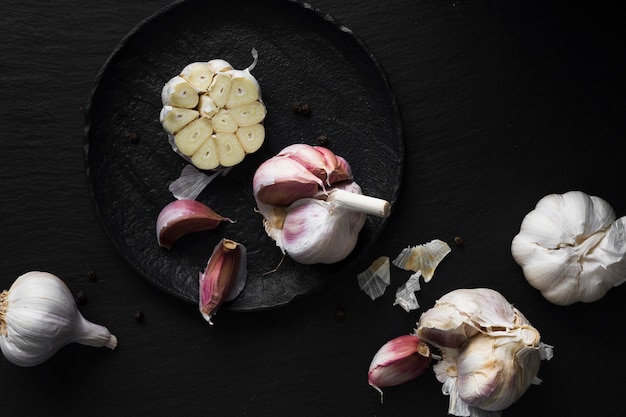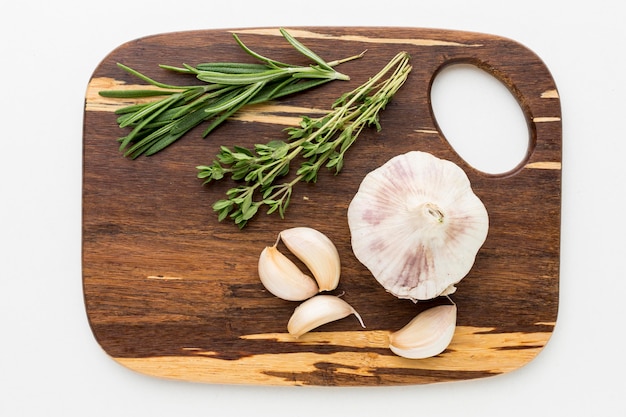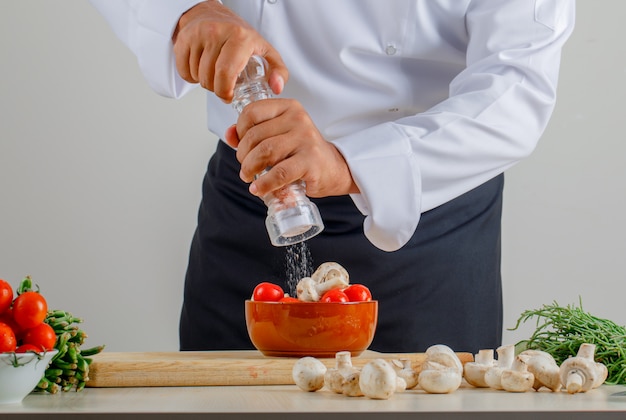Garlic. It's the humble bulb that's the heart and soul of so many dishes, adding a depth of flavour that's simply irresistible. From the delicate hint of garlic in a simple pasta sauce to the powerful punch of flavour in a fiery Thai curry, garlic elevates every culinary experience. Over the years, I've become obsessed with this aromatic wonder, learning everything I can about its nuances and the art of using it to its fullest potential. So, grab your apron, and let's dive into the world of garlic together!
(Part 1) The Garlic Primer: Choosing and Storing

Before we start chopping, let's talk about choosing the perfect garlic. It's all about picking the right bulb. You want one that feels firm and heavy for its size. Give it a gentle squeeze – it should feel solid, with no soft spots or squishy bits. A good garlic bulb should also have a papery skin that's tightly wrapped around the cloves. If the skin is loose or looks damaged, it's best to choose another one. And remember, the more cloves in a bulb, the more garlic you'll get to enjoy!
The Importance of Fresh Garlic
Garlic's flavour is most potent when it's fresh. A good rule of thumb is to always smell the garlic before you buy it. It should have a slightly pungent, earthy aroma. If the garlic smells weak or bland, it's probably not as fresh as it could be.
Storing Garlic: Keeping it Fresh
Storing garlic correctly is crucial to keeping it fresh and flavourful. The ideal storage conditions are cool, dark, and dry. I always store mine in a ceramic garlic keeper in a cupboard, but a mesh bag in the pantry works just as well. Avoid storing garlic in the fridge – it tends to lose its flavour and become mushy.
If you find yourself with a lot of garlic and you're worried about it going bad, you can always freeze it. Simply peel and mince the garlic, then freeze it in ice cube trays with a little olive oil. This way, you'll always have ready-to-use garlic for those last-minute cooking emergencies.
(Part 2) Getting Started: Peeling and Mincing

Alright, now we're getting into the nitty-gritty. It's time to tackle the age-old question: How do you peel garlic efficiently?
Classic Peeling Methods
Let's start with the traditional methods. The first is the "knife method". Simply flatten the clove with the flat side of your knife, then peel off the papery skin. It's a simple technique, but it can be a bit messy.
The second is the "smash and peel" method. Use the flat side of your knife to smash the clove, then peel off the skin. This method is slightly faster, but it can sometimes be difficult to remove the entire skin.
Microwave Magic: A Faster Alternative
But my favourite method by far is the "microwave method." Just pop a whole bulb of garlic in the microwave for about 10 seconds (adjust the time depending on the power of your microwave). The cloves will magically slip out of their skins, making peeling a breeze!
Mincing Like a Pro: Tools and Techniques
Once you've peeled your garlic, it's time to mince it. For small batches, a good ol' chef's knife is more than sufficient. But for larger quantities, a garlic press is my go-to tool. It's quick, efficient, and leaves you with beautifully minced garlic. Just be sure to clean the press properly after use, as garlic residue can become a breeding ground for bacteria.
If you're not a fan of gadgets, a chef's knife will do the trick. And here's a little tip: Don't just chop, but also mash the garlic with the flat side of your knife to release its full aroma and flavour.
(Part 3) Cooking with Garlic: Techniques and Tips

Now for the fun part! Garlic is incredibly versatile. It can be used in practically any dish, from hearty soups and stews to delicate pasta sauces and vibrant stir-fries. However, there are a few things to keep in mind when incorporating it into your cooking.
Adding Garlic at Different Stages
The stage at which you add garlic to your dish significantly impacts the flavour profile.
- Slow and Steady: For dishes that simmer for a long time, like stews or braises, add garlic early on. This allows it to mellow and infuse the dish with its rich, comforting flavour. Think of it as a gentle, slow-burning flame, adding a warmth that permeates the entire dish.
- Quick and Powerful: For dishes that cook quickly, like stir-fries or pasta sauces, add garlic towards the end. This keeps its pungent flavour bright and alive, adding a sharp, almost explosive flavour that dances on the palate.
- Finishing Touches: For a subtle hint of garlic, add it right before serving. Drizzle some garlic oil on a finished pasta dish, or sprinkle fresh garlic flakes on top of a salad. This adds a touch of freshness and aroma that lifts the dish to new heights.
The Secret to Garlic's Magic
Garlic is a flavour enhancer, and it often works best in combination with other ingredients. When sautéing garlic, I often add a pinch of red pepper flakes for a touch of heat, or a squeeze of lemon juice for a bright acidity. I love the way the garlic interacts with the other flavours, creating a harmonious symphony of taste.
Think of garlic as the conductor of an orchestra, leading the other ingredients in a beautiful melody of flavour. Experiment with different combinations and discover what works best for your taste buds!
(Part 4) Garlic: The Star of the Show
While garlic is often a supporting player, it can also take centre stage. There are countless dishes where garlic is the main attraction, from the classic garlic bread to the comforting garlic soup. Let's explore a few of my personal favourites:
Garlic Bread: A Timeless Classic
Who doesn't love a warm, crusty loaf of garlic bread? It's a simple dish, but the key is to use good quality bread and fresh garlic. I like to brush my bread with melted butter, then rub it generously with garlic cloves, and sprinkle with a touch of parsley and oregano. Then, pop it under the grill until it's golden brown and bubbly. The result? A symphony of flavour that's both satisfying and comforting.
Garlic Soup: A Comforting Delight
For a comforting bowl of soup on a cold day, look no further than garlic soup. It's simple to make, just sauté garlic with some onions, then add your favourite vegetables and broth. Simmer until the vegetables are tender, and blend until smooth. Season with salt and pepper, and you have a delicious and nourishing soup. The aroma of garlic fills the kitchen, promising a warm and satisfying meal.
Garlic Pasta: A Simple Yet Delicious Meal
Garlic pasta is a classic for a reason. It's so quick and easy, yet it bursts with flavour. Just cook your pasta according to the package instructions, then sauté some garlic with olive oil and chili flakes. Toss the pasta with the garlic mixture, and sprinkle with some grated parmesan cheese. The result is a meal that's both satisfying and comforting, perfect for a quick weeknight dinner.
(Part 5) Garlic: A Global Ingredient
Garlic is a global ingredient, and it's used in cuisines all over the world. From the fiery dishes of India to the delicate flavours of french cuisine, garlic adds its unique touch to countless dishes.
Asian Flavours: Stir-fries and More
In Asian cuisine, garlic is a staple ingredient in stir-fries, soups, and curries. It's often paired with ginger, chili, and soy sauce for a complex and flavourful combination. I love the way garlic adds a depth of flavour to stir-fries, balancing out the sweetness of the vegetables and the richness of the meat or tofu. The combination of garlic, ginger, and chili creates a symphony of flavour that's both exciting and satisfying.
Mediterranean Delights: Olive Oil and Herbs
Mediterranean cuisine is all about fresh ingredients and vibrant flavours, and garlic is a key player. It's often paired with olive oil, lemon, and herbs, like oregano and basil, for a simple yet delicious combination. Think of classic dishes like pesto, bruschetta, and roasted vegetables. The earthy flavour of garlic complements the Mediterranean staples beautifully, creating a harmonious blend of flavours that's both fresh and satisfying.
Latin American Spices: Chili and Lime
Garlic is a common ingredient in Latin American cuisine, where it's used in dishes like salsa, guacamole, and ceviche. It's often combined with chili peppers, lime juice, and cilantro for a fiery and refreshing flavour. I'm particularly fond of how garlic balances out the heat of chili peppers, creating a harmonious taste sensation. The combination of garlic, chili, and lime is a perfect example of how garlic can be used to create a complex and satisfying flavour profile.
(Part 6) Garlic: A Healthy Choice
Beyond its flavour, garlic is also known for its health benefits. It's a good source of antioxidants and vitamins, and it's been linked to boosting the immune system, improving heart health, and even fighting cancer. While more research is needed to confirm these benefits, adding garlic to your diet is definitely a good thing for your overall well-being.
Garlic: A Natural Antibiotic
Garlic has been used for centuries as a natural remedy for various ailments. It contains allicin, a compound with potent antibacterial and antiviral properties. A clove of garlic a day might not cure all your ills, but it certainly can help to strengthen your immune system and keep those pesky colds at bay!
Garlic: A Heart-Healthy Hero
Studies have shown that garlic can help lower blood pressure and cholesterol, both of which are important factors in maintaining heart health. Garlic's ability to thin the blood can also help to prevent blood clots, reducing the risk of heart attacks and strokes. So, adding a little garlic to your meals could potentially be a positive step towards a healthier heart.
(Part 7) Garlic: Beyond the Bulb
We've been focusing on the classic garlic bulb, but there's a whole world of garlic-related ingredients to explore.
Garlic Scapes: A Springtime Treat
Garlic scapes are the flower stalks of garlic plants. They have a milder, more grassy flavour than garlic cloves, and they're a delicious addition to stir-fries, pasta dishes, and even pizzas. I love to sauté them with a little olive oil and salt, or to grill them until they're tender and slightly charred.
Black Garlic: A Sweet and Savory Delight
Black garlic is a fermented garlic that has a sweet and savory flavour, reminiscent of balsamic vinegar or dates. It's a great addition to salads, dips, and sauces, and it can even be used as a glaze for roasted vegetables. Black garlic adds an unexpected twist to dishes, and it's definitely worth trying if you're looking for a unique flavour experience.
Garlic Powder: A Convenient Option
Garlic powder is a convenient way to add garlic flavour to your dishes without having to chop or mince fresh garlic. It's a staple in my pantry, and I use it in everything from soups and stews to marinades and rubs. It has a more concentrated flavour than fresh garlic, so use it sparingly.
(Part 8) Garlic: A culinary adventure
As you can see, garlic is a truly versatile ingredient that can enhance the flavour of countless dishes. It's also a great way to add a touch of personality to your cooking. So don't be afraid to experiment, try new things, and discover your own unique way of incorporating garlic into your culinary creations.
Tips for Mastering Garlic
Here are a few more tips for cooking with garlic like a pro:
- Don't overcook garlic. It can easily burn and become bitter. Just a few minutes of sautéing is all it takes to release its flavour.
- Use a good quality olive oil. It will enhance the flavour of the garlic and create a delicious base for your dish.
- Add a pinch of salt to the garlic when you're sautéing it. This will help to draw out the flavour and prevent it from sticking to the pan.
- Don't be afraid to use a lot of garlic! The more the merrier, in my opinion. But of course, adjust the amount to your personal taste.
- Don't be afraid to experiment! There are endless possibilities when it comes to cooking with garlic. So get creative and have fun!
FAQs
1. How do I know if garlic is bad?
If you see any signs of mold, sprouting, or a strong, unpleasant odor, it's best to discard the garlic. It's also a good idea to check for firmness, if the garlic feels soft or squishy, it's probably not fresh anymore.
2. How long can I store garlic?
Fresh garlic can last for several weeks if stored properly in a cool, dark, and dry place. Garlic that's been peeled can be stored in the refrigerator for up to a week. Freezing garlic is a great way to preserve it for longer, it can last for up to 6 months in the freezer.
3. Can I use garlic powder instead of fresh garlic?
You can use garlic powder as a substitute for fresh garlic, but it will have a more concentrated flavour. Start with a smaller amount and adjust to taste.
4. Is garlic good for you?
Yes, garlic is considered a healthy food. It's a good source of antioxidants and vitamins, and it's been linked to various health benefits, such as boosting the immune system and improving heart health.
5. What are some good recipes using garlic?
There are countless recipes that feature garlic, from simple dishes like garlic bread and garlic pasta to more complex dishes like roasted lamb with garlic and rosemary, or chicken cacciatore. Just search online for "garlic recipes" and you'll find a world of culinary inspiration.
So, there you have it, the ultimate guide to cooking with garlic! Now go forth and conquer the culinary world with this versatile and flavourful ingredient. Happy cooking!
Everyone is watching

How to Cook Frozen Lobster Tails Perfectly: A Step-by-Step Guide
RecipesLobster. Just the word conjures up images of lavish meals, special occasions, and a taste of luxury. But let's...

Pigs in a Blanket Cooking Time: How Long to Bake for Perfect Results
RecipesAh, pigs in a blanket. Just the name conjures up images of those delightful little parcels of crispy pastry en...

Pork Fillet Cooking Time: How Long to Cook It Perfectly
RecipesPork fillet, or tenderloin as it's sometimes called, is a real favourite in our house. It's so versatile, and...

The Ultimate Guide to Tender, Juicy Pulled Pork
RecipesRight, let's talk pulled pork. It's one of those dishes that just screams "comfort food," doesn't it? I mean...

The Ultimate Guide to Cooking Sweet Potatoes: From Roasting to Mashing
RecipesSweet potatoes. Just the name conjures up images of warm, comforting dishes, bursts of vibrant color, and a to...
